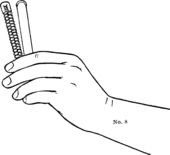Bone (corsetry)
This article needs additional citations for verification. (September 2013) |
In
Modern corset boning comes in two different qualities: the more durable metal and less durable plastic. Since the turn of the 20th century, steel boning was the standard for a high quality corset, coming in two different types: flat spring steel and spiral steel. While spring steel is most preferred for being thin and flexible, it only has the ability to bend in a single direction. Spiral steel is able to bend both horizontally and vertically, its only drawbacks being the fact that it's not as stable and tends to not support larger figures.
Traditionally, plastic boning such as Rigilene has been considered low quality and unsupportive. New advances in plastic boning have brought about synthetic whalebone. It is used widely in historical reconstruction due to its similarities to traditional whalebone. It is lightweight and very supportive. It also molds better to the body, allowing for a much curvier shape.
Purpose, history and materials

The purpose of the boning in a corset varied slightly from era to era. Generally, the cinching/shaping properties of corsetry puts strain onto the
The corsets of the 16th through 18th centuries (called "stays", "
The early 19th century brought a very different style of corset (still called "stays"). A return to the natural or "classical" form was embraced by fashion, and for the first time in corset history, the bust was separated. To achieve and enhance the separation of the bust, the "busk" was used. The busk was essentially a large, rigid "popsicle stick"- shaped bone inserted into a casing down the center front of the corset. These busks were made from either wood, ivory, bone, or baleen and were often elaborately carved and given as gifts. It was most often the only bone within corsets of this type, as other required shaping was provided by the cut of the pattern and enhanced by cording (cotton or similar cords within casings). The cording of the early 19th-century corsets (stays) was often very elaborate, and examples of many beautiful corded stays can be found in museum collections.

The mid-19th century brought more complex corsets (no longer called stays) and tighter lacing, which required more boning to create the desired shape. The modern split busk was popular, as it allowed corsets to easily open in the front. Steel and baleen (whalebone)
By the late 1890s, a lighter, shorter style of corset was becoming popular, coming in simpler shapes and using much less boning than in the previous decade. This style of corset quickly evolved into the beautifully complex early

Modern steel bones come in two basic varieties: "flat" steel boning (sometimes called just "enamel" or "rigid" boning) and "spiral" steel boning. Spiral boning is flattish but thicker than flat boning, because of the tips required on the ends. Flat boning bends in only one direction, while spiral steel boning bends easily in two directions. Spiral steel boning may thus be used in curved channels, or where a more gentle support is acceptable. Both varieties are rigid lengthwise. Modern corset makers differ greatly in the type and size of boning that they use. For those unable to procure steel boning, there are several alternative options, depending on the style of the corset desired. Cable ties (found in 36, 48 and 52 inch lengths) from a hardware store have been used by costumers.
Providing a much more flexible shape, synthetic whalebone comes in a variety of sizes. 4mmx1mm is most suitable for pre-19th century stays, especially fully boned stays. 6mmx1.5 is most suitable for 19th century corsets.
References
External links
- Corsets at Chicago History Museum Digital Collections Archived 2012-04-26 at the Wayback Machine


